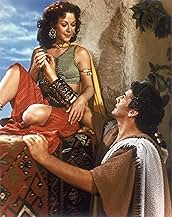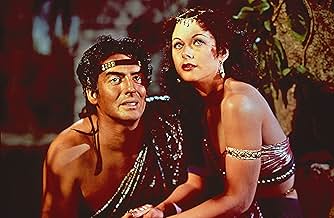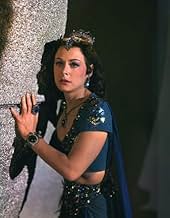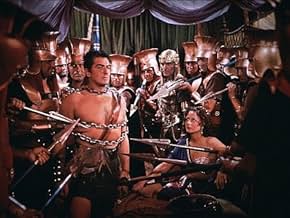IMDb RATING
6.8/10
9.5K
YOUR RATING
When strongman Samson rejects the love of the beautiful Philistine woman Delilah, she seeks vengeance that brings horrible consequences they both regret.When strongman Samson rejects the love of the beautiful Philistine woman Delilah, she seeks vengeance that brings horrible consequences they both regret.When strongman Samson rejects the love of the beautiful Philistine woman Delilah, she seeks vengeance that brings horrible consequences they both regret.
- Won 2 Oscars
- 7 wins & 5 nominations total
Russ Tamblyn
- Saul
- (as Russell Tamblyn)
Francis McDonald
- Story Teller
- (as Francis J. McDonald)
William 'Wee Willie' Davis
- Garmiskar
- (as William Davis)
Kasey Rogers
- Spectator
- (as Laura Elliot)
Featured reviews
Biblical epic that became the biggest hit, up until then, in Paramount Pictures history. The story about the Hebrew Hercules Samson, Victor Mature, who redeemed himself from a life of foolhardiness and slavery by taking down the Temple of Dagon, the Philistine Idol God. Samson not only destroyed Dagon's temple he took the lives, together with his own, of 3,000 of his bitter enemies and tormentors in the movies', Samson and Delilah, spectacular and ground shaking final scene.
Never living up to what God wanted from him, to lead his people the ancient Israelites against the hated and occupying Philistines, Samson instead lead a life of womanizing and partying mostly with the Philistines who more then anything else wanted him dead. Because of his super-human strength Samson felt safe from anything that the Philistines could do to him, killing hundreds who tried, in capturing or killing the biblical strongman.
It's when the Philistine temptress the drop-dead gorgeous Delilah, Hedy Lamarr, got to work on the big guy that he left himself open to be captured, by the Philistine army, in revealing the source of his strength; His black curly locks of hair on his head. Blinded, with a red hot iron put to his eyes, Samson was then forced to pull the grind-mill and made to look helpless as he was brutally mocked and tortured by his Philistine captors.
As the days weeks and months went by and his hair, the source of his great strength, grew back Samson with Delilah's, who had since repented what she did to him, help then planned to finish the job that he never really started; annihilate his and his peoples enslavers the hated Philistines. Samson did it by, with Delilah's leading him to them, tearing down the pillars that held up Dagan's temple and thus bringing the entire house down.
The film "Samson and Delilah" still holds up quite well despite it's bargain basement, compared to those now, special effects. Victor Mature as Samson was at his best being able to show off his hunky body without having to wear a suit and tie, as well as pants, like in his previous blockbusters "Kiss of Death" and My Darling Clementine". Heady Lamarr in her first Technicolor movie showed why she was considered to be, just get a load of her violet/lavender eyes, the most beautiful women in the world at that, back in 1950, time.
The movies director Cecil B. DeMille really had very little to go on in making the biblical blockbuster in that it was based on only four chapters, the 13 to 16, of the Book of Judges. It was an obscure 1930 German language novel "the Judge and the Fool" by Vladimir Jabotinsky that filled in all the gaps and made a full length two hour plus film about the subject, Samson & Delilah, possible.
Never living up to what God wanted from him, to lead his people the ancient Israelites against the hated and occupying Philistines, Samson instead lead a life of womanizing and partying mostly with the Philistines who more then anything else wanted him dead. Because of his super-human strength Samson felt safe from anything that the Philistines could do to him, killing hundreds who tried, in capturing or killing the biblical strongman.
It's when the Philistine temptress the drop-dead gorgeous Delilah, Hedy Lamarr, got to work on the big guy that he left himself open to be captured, by the Philistine army, in revealing the source of his strength; His black curly locks of hair on his head. Blinded, with a red hot iron put to his eyes, Samson was then forced to pull the grind-mill and made to look helpless as he was brutally mocked and tortured by his Philistine captors.
As the days weeks and months went by and his hair, the source of his great strength, grew back Samson with Delilah's, who had since repented what she did to him, help then planned to finish the job that he never really started; annihilate his and his peoples enslavers the hated Philistines. Samson did it by, with Delilah's leading him to them, tearing down the pillars that held up Dagan's temple and thus bringing the entire house down.
The film "Samson and Delilah" still holds up quite well despite it's bargain basement, compared to those now, special effects. Victor Mature as Samson was at his best being able to show off his hunky body without having to wear a suit and tie, as well as pants, like in his previous blockbusters "Kiss of Death" and My Darling Clementine". Heady Lamarr in her first Technicolor movie showed why she was considered to be, just get a load of her violet/lavender eyes, the most beautiful women in the world at that, back in 1950, time.
The movies director Cecil B. DeMille really had very little to go on in making the biblical blockbuster in that it was based on only four chapters, the 13 to 16, of the Book of Judges. It was an obscure 1930 German language novel "the Judge and the Fool" by Vladimir Jabotinsky that filled in all the gaps and made a full length two hour plus film about the subject, Samson & Delilah, possible.
I first saw this as a kid in the early 80s n was blown away by the lion fight sequence n the climax scene of that of Dagon's towering idol.
Saw many times aft that n coincidentally revisited it again on this Easter (04/04/21).
This one is a classic action movie n i still found it very captivating.
The film was very violent for its times. Samson using a jawbone of a donkey to crush skulls like eggs thru helmets is very brutal.
The film's special effects are noteworthy and the most spectacular special effect in the film is the toppling of the temple of Dagon.
Saw many times aft that n coincidentally revisited it again on this Easter (04/04/21).
This one is a classic action movie n i still found it very captivating.
The film was very violent for its times. Samson using a jawbone of a donkey to crush skulls like eggs thru helmets is very brutal.
The film's special effects are noteworthy and the most spectacular special effect in the film is the toppling of the temple of Dagon.
This film is a must for everyone who loves Technicolor, great actors and great movies. Mature is a wonderful Samson but Hedy Lamarr is the definitive incarnation of beauty. She is also a very good actress and directed by De Mille gets her screen triumph. Watch this over and over again and you'll not be tired.
While having some very major flaws, this is a thoroughly decent biblical epic on the story of Samson and Delilah. It is nicely filmed, with lovely costumes, nice sets and good cinematography and has a rousing score. Also the acing is not bad at all, Victor Mature is a dashing Samson and Hedy Lamarr pretty much steals the film as the beautifully captivating Delilah, it somehow reminded me of Rita Hayworth in Salome. George Sanders proves here he is the epitome of calculation and world-weariness, and while Angela Lansbury is good she has been better. Plus the final scene with the temple coming down is brilliantly staged and serves as the highlight of the film. However, the script is not always that great, neither is the pacing which is quite slow or the direction which is disappointingly stodgy. Overall though, Samson and Delilah isn't bad, it could've been better, but it was decent. 7/10 Bethany Cox
Cecil B. DeMille is best remembered for his biblical epics, even though in a forty-year, eighty-film career he only made four of them. It wasn't just that the bible pictures gave him some of his biggest hits; it was in these features that DeMille seemed most at home, and the one genre in which he had unique ability.
Samson and Delilah brought an end to a long phase of epic-cum-adventure movies from DeMille. This period, beginning with The Plainsman in 1936, had some of the weakest pictures of his career for a number of reasons. For one thing, DeMille was not really very good at individualistic action scenes, and there was too much DeMillean historical grandeur and not enough of the free-spirited feel of the Errol Flynn or Tyrone power swashbucklers he was to some extent an trying to copy. What's more, these were mostly original stories or, at least, ones which were not well known, and DeMille's poor choice of source material and screenwriters meant the new characters and situations tended towards the feeble. DeMille's strength lay in his staging and presentation of a familiar tale, and as such his return to Sunday-school moralising, stuffy and pompous though it may be, is apt and welcome.
You see, DeMille was probably aware on some level that although these fables were well-known in a largely Christian society, to a modern audience they were also historically distant, emotionally neutral and even ridiculous when presented literally. But DeMille never attempted any humanity or realism in his features, instead turning the remote, mythical nature of the stories into a virtue, portraying his subject matter with a kind of dignity and grace. Of course most ancient world epics do this to some extent, but DeMille did it the most effectively because he never demanded that the audience sympathise with the characters, merely that we marvel at their deeds.
Specifically, DeMille composes the picture with overstated gesturing and painterly tableau, like a Gustave Dore print come to life. This is combined with the vivid colours of a bible stories illustration, coded with drab shades for humbleness and virtue, garish ones for extravagance and sin. Throughout, DeMille's flair for dreamlike, rhythmic motion keeps the images flowing, most notably in the establishing tracking shot at the wedding feast - although if you watch closely you'll see one of the two men engaged in a mock swordfight is actually camply slapping his opponent with a feather duster.
And DeMille was perhaps unique in that he even used the imagery to turn God into a character. You can see from one of his much earlier religious pictures, 1929's The Godless Girl, that DeMille associated God with natural beauty, and in Samson and Delilah God makes several key "appearances" as a breathtaking skyscape. This touch would be expanded upon in the 1956 version of Ten Commandments.
It's a pity DeMille didn't associate God with good acting, because even the theatrical presentation on offer here could do with at least some half-decent hamming. The trouble is DeMille chose his actors for their physicality, not for their ability to qualify their job description. In this respect Victor Mature and Hedy Lamarr are natural choices. DeMille's business associate Henry Wilcoxon, whom the director unbelievably used to cast in lead roles, is as wooden as ever, and the somewhat hit-and-miss Angela Lansbury, misses this time. The only standout is George Sanders who proves, just as Herbert Marshall did in DeMille's Four Frightened People, that bad dialogue becomes bearable if you underplay it.
Fortunately when it came to crew DeMille always procured the best. Samson and Delilah boasts Oscar-winning costumes and art direction from no less personages than Edith Head and Hans Dreier respectively. The Technicolor cinematography is great, with some remarkably clear night time shots. Some of the effects may be a little dubious; whenever Victor Mature lifts up something heavy it's obvious it's being hoisted from offscreen, and that woolly-rug/lion tamer scene is actually betrayed by bad editing, but overall this is a solid, high-quality production.
Yes, Samson and Delilah is as corny as anything, but it looks great, and above all it entertains. Don't be too harsh on DeMille's staginess or his archaic moralism, for as his willing appearance as himself in Sunset Boulevard proves, he probably didn't have a sense of irony. And his earnestness was probably his greatest asset.
Samson and Delilah brought an end to a long phase of epic-cum-adventure movies from DeMille. This period, beginning with The Plainsman in 1936, had some of the weakest pictures of his career for a number of reasons. For one thing, DeMille was not really very good at individualistic action scenes, and there was too much DeMillean historical grandeur and not enough of the free-spirited feel of the Errol Flynn or Tyrone power swashbucklers he was to some extent an trying to copy. What's more, these were mostly original stories or, at least, ones which were not well known, and DeMille's poor choice of source material and screenwriters meant the new characters and situations tended towards the feeble. DeMille's strength lay in his staging and presentation of a familiar tale, and as such his return to Sunday-school moralising, stuffy and pompous though it may be, is apt and welcome.
You see, DeMille was probably aware on some level that although these fables were well-known in a largely Christian society, to a modern audience they were also historically distant, emotionally neutral and even ridiculous when presented literally. But DeMille never attempted any humanity or realism in his features, instead turning the remote, mythical nature of the stories into a virtue, portraying his subject matter with a kind of dignity and grace. Of course most ancient world epics do this to some extent, but DeMille did it the most effectively because he never demanded that the audience sympathise with the characters, merely that we marvel at their deeds.
Specifically, DeMille composes the picture with overstated gesturing and painterly tableau, like a Gustave Dore print come to life. This is combined with the vivid colours of a bible stories illustration, coded with drab shades for humbleness and virtue, garish ones for extravagance and sin. Throughout, DeMille's flair for dreamlike, rhythmic motion keeps the images flowing, most notably in the establishing tracking shot at the wedding feast - although if you watch closely you'll see one of the two men engaged in a mock swordfight is actually camply slapping his opponent with a feather duster.
And DeMille was perhaps unique in that he even used the imagery to turn God into a character. You can see from one of his much earlier religious pictures, 1929's The Godless Girl, that DeMille associated God with natural beauty, and in Samson and Delilah God makes several key "appearances" as a breathtaking skyscape. This touch would be expanded upon in the 1956 version of Ten Commandments.
It's a pity DeMille didn't associate God with good acting, because even the theatrical presentation on offer here could do with at least some half-decent hamming. The trouble is DeMille chose his actors for their physicality, not for their ability to qualify their job description. In this respect Victor Mature and Hedy Lamarr are natural choices. DeMille's business associate Henry Wilcoxon, whom the director unbelievably used to cast in lead roles, is as wooden as ever, and the somewhat hit-and-miss Angela Lansbury, misses this time. The only standout is George Sanders who proves, just as Herbert Marshall did in DeMille's Four Frightened People, that bad dialogue becomes bearable if you underplay it.
Fortunately when it came to crew DeMille always procured the best. Samson and Delilah boasts Oscar-winning costumes and art direction from no less personages than Edith Head and Hans Dreier respectively. The Technicolor cinematography is great, with some remarkably clear night time shots. Some of the effects may be a little dubious; whenever Victor Mature lifts up something heavy it's obvious it's being hoisted from offscreen, and that woolly-rug/lion tamer scene is actually betrayed by bad editing, but overall this is a solid, high-quality production.
Yes, Samson and Delilah is as corny as anything, but it looks great, and above all it entertains. Don't be too harsh on DeMille's staginess or his archaic moralism, for as his willing appearance as himself in Sunset Boulevard proves, he probably didn't have a sense of irony. And his earnestness was probably his greatest asset.
Did you know
- TriviaFor the scene in which Samson kills the lion, Victor Mature refused to wrestle a tame movie lion. Told by Producer and Director Cecil B. DeMille that the lion had no teeth, Mature replied, "I don't want to be gummed to death, either." The scene shows a stuntman wrestling the tame lion, intercut with close-ups of Mature wrestling a lion skin.
- GoofsJust after Delilah rings for her servant to bring dinner, the mike boom casts a shadow on one of the curtain walls of her tent.
- Crazy creditsAlthough the opening credits mention "Holy Land Photography," the second-unit location shooting occurred in North Africa (Algiers and Morocco), not Israel or the Middle East.
- Alternate versionsPrevious home media releases of the film (LaserDisc, VHS) did not include the overture and exit music. They were restored for Paramount's official DVD release in 2013 and the subsequent Blu-ray release in 2014.
- ConnectionsFeatured in History Brought to Life (1950)
Details
- Release date
- Country of origin
- Official site
- Language
- Also known as
- Samson and Delilah
- Filming locations
- Production company
- See more company credits at IMDbPro
Box office
- Budget
- $3,000,000 (estimated)
- Runtime2 hours 14 minutes
- Color
- Aspect ratio
- 1.37 : 1
Contribute to this page
Suggest an edit or add missing content








































